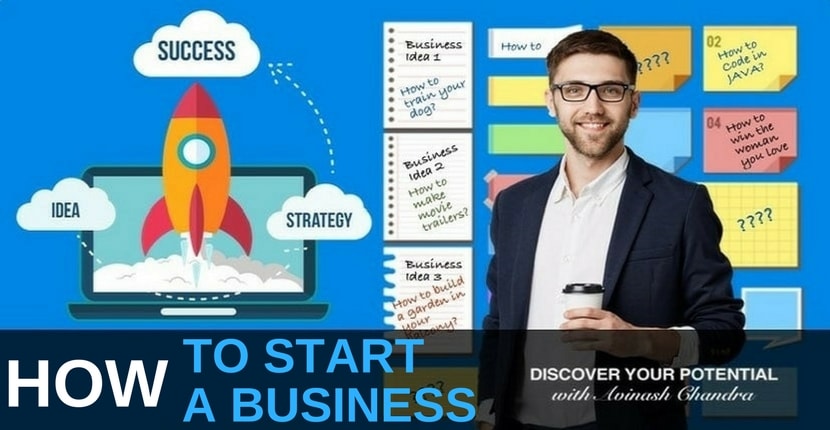So you are planning a startup business. Starting a Business is a great thought and if you are reading this article probably you are looking for some assistance. Here is how to Start a Business in India with Low Investment Successfully. Get Inspired & Start one of yours Now.
This post is part 2 of my “Be your Own Boss” series.
Part 1: Business Ideas – Get inspired & choose.
Part 2: How to start a Business with Low Investment. <<YOU ARE HERE>>
Part 3: wordpress.com vs wordpress.org – everything about choosing the right platform.
Part 4: How to create a website/blog.
Part 5: How to choose & install a WordPress theme
Part 6: Essential settings after installing WordPress
Part 7: How to install a WordPress plugin
Part 8: Tried and tested ways to start Promotion of your blog / website
Part 9: How to Grow your Business online
I want to start my own business!
This is a great thought. Yet, before you decide to leave the safety net of your full-time job, please be clear that as a business owner you are getting into a crazy rollercoaster ride.
Yes, Entrepreneurship is rewarding, however just for a few. You get to hear only the success stories.
Whatever be your Business Idea, online or offline, it is going to be a long and a bumpy road ahead.
Be willing to invest your time, spirit and savings into it. Your Business Idea is going to go for an overhaul through the way before it becomes successful.
Your friends and family are also Starting a new Business
As per GEM 2016-2017 report, (by Global Entrepreneurship Monitor) on an average:
42% of working-age adults(1) globally see good opportunities for starting a business in their area of interest or expertise.
Therefore it is quite natural that several new and small business ideas keep taking shape across the world. Most probably your best friend is also looking for promising business ideas just like you.
However, economist recently observed in an article that(2):
- In America, the rate of business creation has declined since the late 1970s.
- During the last few years, more companies died than were born.
- In Europe, high-growth ones are still rare, and most startups stay small.
- These startups are plagued by the tax systems, which punish outfits that employ a certain number of workers.
- Also because entrepreneurs care more about work-life balance than growth for its own sake.
- A large number of business people who were drawn in by the cult of entrepreneurship encountered only the failure and now eke out marginal existences with little or no provision for their old age.
Yes that is pretty scary.
Is there a Future for Start up Business Ideas
Now let us connect the above with what the Global Entrepreneurship Monitor reported further:
- There is very little difference between the economies, about opportunity perception experienced by a prospective entrepreneur.
- What it means is that a prospective entrepreneur in a developed economy to a third world economy see similar levels of opportunity to start a new business idea.
- A little more than half the adults believe that they have the required skills to start a business.
- A third indicated that the fear of failure would inhibit them from pursuing entrepreneurial opportunities.
But here’s the kicker:
At an overall level, 22% of the people surveyed in the 64 economies expressed an intention to start a business in the next three years.
So what’s the bottom line?
If you are looking for an answer to your questions like:
- how to start a business
- how to start an online business
- how to start a small business
- how to start a business in india
- how to start a business without money
- how to start a new business
- how to start a home business
you are in the right place. You are already thinking about it, and most probably you are reading this blog to see if you can make your business idea successful.
Here’s the deal –
In this article, I will try to answer several such questions or doubts you have in your mind.
I will also share with you list of several already successful real life business ideas.
When I am sharing these lists, my objective is not to drive you away from what you already have in your mind, but to help you realise the opportunities that exist today in front of you, me and many others like us.
Now, not sure if it gets better/worse:
I promise not to bore you to death with one-liners on 100 or 150 or 200 business ideas with low investment requirements.
I am going to share with you real-life examples of already successful business ideas. You can dig deeper to learn more about their business model.
🙂
I will attempt to help you build a sustainable and profitable business.
So let us get going.
How to Start a Business in India with Low Investment
Starting a business is not easy, however it is rewarding. If it was so easy, everybody would have been doing it. While there are several things you need to do in terms of documentation, I will leave it to the last. For me the more important things are around getting your mind to a finalising a profitable business idea.
Generating a Business Idea & Writing a Business Plan
Most executives, many scientists, and almost all business school graduates believe that if you analyze data, this will give you new ideas. Unfortunately, this belief is totally wrong. The mind can only see what it is prepared to see.
All of us, including you and I always want to invest our time or money or other resources in a good business idea.
But let me tell you:
There is nothing like a bad or good business idea.
It all depends on
- who we are,
- how much we believe in a particular business idea and
- how we execute it.
However, the question remains, how to generate a new business idea?
All of us have many opportunities around us.
You are surrounded by simple, obvious solutions that can dramatically increase your income, power, influence and success. The problem is, you just don’t see them.
You might be thinking of starting something you are passionate about or where you possess expertise in.
Below are four strategies I believe can help you in generating a new business idea and writing a business plan.
1. Get your mind and body in a Rhythm
True enjoyment comes from activity of the mind and exercise of the body; the two are ever united.
– Wilhelm Von Humboldt
I think when your mind and body are in a rhythm, you produce the best business idea or can see the possibilities.
Go for a walk or run and allow your mind to ruminate the new business idea you have in your mind. The physical exertion you are going through will help you cut off the stress of your life, and you can concentrate.
I can assure you that you will see many other limitations and possibilities of your new business ideas.
2. Focus on big picture
Business ideas are not about what but it is all about why.
A mediocre idea that generates enthusiasm will go further than a great idea that inspires no one.
– Mary Kay Ash
Most successful business ideas started out to solve a particular problem. The entrepreneurs behind it believed that it would make a difference to the world.
However, at a time when you have a new business idea, we forget why we are doing it. What is the big picture? We lose the sight of our ultimate goal.
All your actions are directed towards ensuring the execution.
However, at this juncture what is most important to determine is, does it make sense to do it. You need to think if there is a better way of doing it.
3. Unlearn first and then – learn something new
What we are witnessing in the business world is exponential changes.
Have you noticed what Economist observed above? Just imagine if you do not unlearn, what you already know could be a barrier to your success.
Having to be right becomes a barrier to unlearning and understanding. – John Naisbett
All of us have our share of experience and baggage. As an entrepreneur, one thing I have learned the hard way is that unlearning is far more important than learning something new.
We know that we do not know all the laws yet … therefore things must be learned only to be unlearned again.”
Richard Feynman
Do not restrict your thoughts within boundaries of what is possible today.
4. Automate your life as much as possible
To turn really interesting ideas and fledgling technologies into a company that can continue to innovate for years, it requires a lot of disciplines
– Steve Jobs.
We have a limited amount of energy and so much to do and achieve in a day. So why waste it is deciding about small things every day. For example, what to eat, what to wear.
That’s why Why Mark Zuckerberg wears the same clothes to work every day!
Yes, the worlds youngest billionaire & Facebook CEO wears the same colour shirt to work every day. Why? Because he knows that he (like all of us) has limited willpower & limited ability to make decisions. So he makes sure that everything else except what really matters (like business decisions) are automated.
In fact Mark said that he owns multiple versions of the same T-shirt, as clothing, along with breakfast, is a “silly” decision he doesn’t want to spend too long making.
🙂

Nevertheless, make what you love beyond your business idea your daily chore. Do not spend time on thinking whether you want to do it or not.
Save that energy to think about what you want to do in your life.
Summary: How to generate a Good Business Ideas
Did you notice that I changed the title line from “How to generate New Business Ideas” to “How to generate a Good Business Ideas”? Yes, I did that intentionally.
If you have ideas, you have the main asset you need, and there isn’t any limit to what you can do with your business and your life. Ideas are any man’s greatest asset.
– Harvey S. Firestone.
Like I said before, there is no good or bad business idea. It is all about why you are doing it and how you do it. All ideas can become good ideas if you can stay focused on the above mentioned four steps.
To be successful with a new business idea, it is a must that it becomes your heart and soul. You need to stop investing your time in other things and focus on your business idea alone.
How to Identify Best Business to Start in India
So now you have a business idea. What next?
- Are you wondering that if this is the best business to start with little money?
- Do you think that you have a business idea that is relevant and differentiating enough?
- Will you be able to generate enough profit from your business?
- And finally, should be leaving your well-paying job to follow your dream or passion?
You will be able to answer all the above questions, once you evaluate your business idea correctly. Once you have assessed the need of your business ideas and done its financial analysis, you will have the confidence to enter the uncharted terrain.

Below are the steps you need to take to evaluate your business idea:
1. Assess the need for your Business Idea
Research your idea. See if there’s a demand. A lot of people have great ideas, but they don’t know if there’s a need for it. You also have to research your competition
Whatever may be your business idea, it will be successful only if there is a need for it in the marketplace.
Consider the following questions to evaluate the need:
- Who will be your target customer?
- What is their latent need or problem that you intend to serve?
- Focus on one significant need, do not try to solve several significant needs at a time.
- What you have to offer them and how it is going to fulfil their need?
- Please consider conducting market research to gain insights on this. You can do it yourself or hire a professional market research agency.
- A survey will provide you with some fantastic insights on the viability of your business idea.
- Are there any existing incumbent offering similar or somewhat similar services?
- Consider the competitive intensity.
- If there are too many players offering the same services you need to reconsider your plan.
- If you decide to go ahead, please choose a niche or determine how you are going to differentiate against these competitors.
- Determine what make your business idea unique?
- Consider how you are going to position it to succeed.
- Consider the competitive intensity.
- Is there any location constraint to be successful.
- Depending on your business idea you may need to at a particular location.
- Such requirements increase the initial cost of such businesses.
2. Evaluate the Potential Customer base
The strength of a business idea depends on its potential customer base. From the step 1 above, now you know who your customer is. Now is the right time to evaluate whom you will be servicing.
I have come across instances, where some of my clients told me that there are millions of potentials consumers in the country. However, when they were starting off, the plan was to serve a specific geography or a niche customer group. In such a situation it is a must to be clear whom you are servicing today and when you plan to start serving others.
Consider the following steps to evaluate the potential customer base for your business idea:
- Define the customer segment you plan to connect with in the beginning.
- What are their needs that you can address profitably?
- How can you convince them to try out your product or service?
- What is market demand trend? Can you observe any changes in the typical consumer mental maps that may affect need of your product or services?
- Review the demographic trends. Do you have a sizable potential audience?
3. Conduct a thorough Financial Analysis
Well, this is something that is going to be always under evolution. However, keeping an eye on finances is a critical determinant of the success of your venture.
Pay a special emphasis on CASH FLOW, ignore it at your own peril. If you are not getting paid on time what is the point in running the business?
For many professionals talking about money is a difficult discussion. I ignored it and paid dearly for it. The earlier you let go your inhibitions, the better it is. You like it or not your entire approach to money is going to change in next few months or years depending on how much savings you have got.
That is why Cash is King!
Below are the steps you need to conduct to do a thorough financial analysis:
- Try to estimate the market size of the industry you are planning to enter.
- In a pre-existing industry look for industry sales data from business journals or similar sources.
- For an entirely new product category, you need to make assumptions and hypothesis to estimate the market size.
- You can also build your approach by the product or service that might be satisfying the specific need you are planning to address.
- Your business buildup plan. Are you planning to acquire customers from competition or you will be looking at first time users?
- If you are planning to acquire share from other players, what will be their response?
- Profit margin: You need to consider the profit margin you are going to earn. An operating profit margin of 25% and above is generally considered to be favourable by most financial analysts.
- Starting up costs: What will be the requirement for initial setup. If you need significant investments, you need to ensure you have budgets available.
- Need of a physical office?
- Investment requirement for inventory and supplies.
- Do you need employees?
- Investment requirement?
4. Consider your involvement
Business ideas are like babies. You need to nurture them and invest a significant amount of time to make them succeed. Therefore, before you start off, please consider how you are going to manage them. Are you doing it along with your job or study? If you are a homemaker with kids, you need to find time, energy & money for your personal life as well.
Several entrepreneurs drop off from schools to pursue their dream of starting something new. Are you willing to take such a challenge? I mean is that a good idea?
Summary: How to evaluate your Business Idea
If you don’t know where you are going, you’ll end up somewhere else.
Business Idea evaluation is an essential step in building your business from scratch. This step helps you identify milestones and micro-successes. If you do not recognise and define them, it is unlikely that you will achieve what you want to achieve.
How to start a business with a Winning Value Proposition
For business ideas to be successful its value proposition needs to be valuable to a paying customers. Therefore, demand for a product or service is created if you offer exceptional utility at an attractive price while earning tidy margins.
However, this is easier said than done. Most entrepreaneurs find it hard to make their business idea truly relevant and differentiated against competitors. The result is a me too product, leading to price wars & lower margins and ultimately failure of the business idea.
Here are three tools that will help you to convert your business idea into a winning value proposition: (14)
- The first tool: The Buyer Utility Map. This tool indicates the likelihood that customers will be attracted to the new idea.(14)
- The second tool: The price corridor of the mass. This tool the pricepoints that will unlock the greatest number of customers.(14)
- The third tool: The business model guide. This tool offers a framework for figuring out whether and how a company can profitably deliver the new idea at the targeted price.(14)
1 Creating Exceptional Utility
Successful businesses focus on the product’s utility. These businesses try to identify where and how the new product or service will change the lives of its consumers.
The buyer utility map helps you think about all the levers that you can pull to:
- Deliver exceptional utility to your customers
- Deliver different experiences your customers can have of a product or service.
- Identify the full range of utility propositions that a product or service can offer.
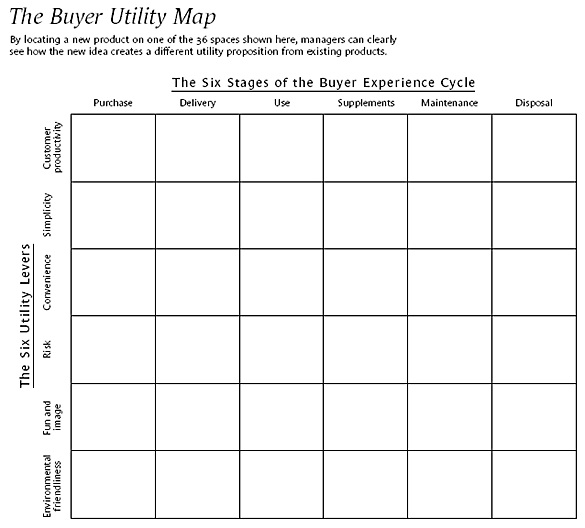
A Business can identify a new product on one of the 36 spaces in the utility map to create a different utility proposition from competing products. To learn more about the map let us understand more about the two axis.
- The Buyer Experience cycle
- Six Utility levers
The six stages of the buyer experience cycle:
A customer’s experience with a product can be broken down into a cycle of six distinct stages. During these stages a consumer goes from purchasing a product to disposing it. Each stage encompasses a wide variety of specific experiences. A business can provide exceptional experience during these cycles.
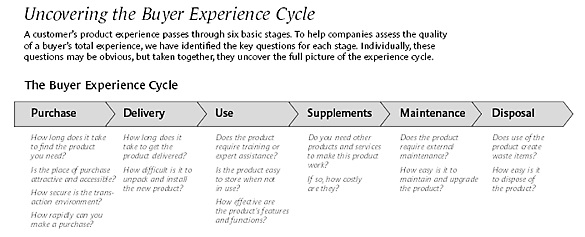
The six utility levers.
Companies have various levers to provide customers exceptional experience. Companies can unlock the value with during the journey from purchase to disposal.
By locating a new product on one of the 36 spaces of the buyer utility map, businesses can create a different value proposition from existing products. Such an offering is differentiated in the marketplace and offers a great opportuinity to build a profitable business.
Therefore, the buyer utility map reminds a business owner how many unexplored innovation possibilities there are. Even the most productive innovators end up occupying only a small number of the 36 utility spaces.
2 Setting a Strategic Price
A product offering is always a function of its exceptional utility and the right price. Your pricing should help you quickly create a large pool of customers.
You need to reach high volumes very quickly, otherwise you might miss the bus altogether. Here is why it is critical to reach large volumes very quickly:
- Volume generates higher returns than it used to. Today the nature of goods is much more knowledge intensive, therefore the majority of cost is at the product development stage instead of manufacturing. Therefore, once your product development cost is covered you can earn much more profit. (14)
- The second reason is a phenomenon called network externalities. Many products and services are an all-or-nothing proposition: either you sell millions at once or you sell nothing at all.(14)
The price you choose for a product must not only attract customers in large numbers but also help you to retain them. This is called strategic pricing.
For customers to remain loyal, they must be convinced that they will not find better value with an imitator.
A company’s reputation has to be earned on day one. Brand building these days relies heavily on word-of-mouth recommendations spreading rapidly through our networked society. Companies, therefore, must start with an offer that customers just can’t refuse.
This is where a tool called the price corridor of the mass comes into picture. This tools helps you to find the right price for that irresistible offer. Well, please note that that is not necessarily the lowest price. The tool involves two distinct but interrelated steps.
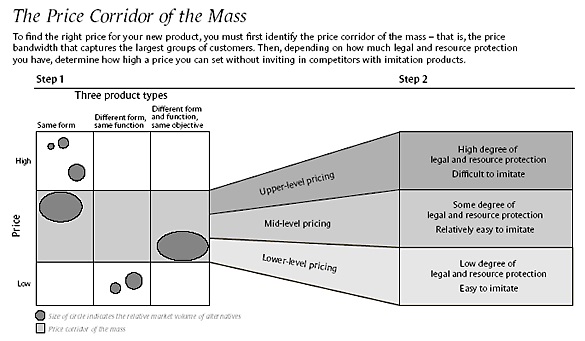
The Price Corridor of the Mass is the bandwidth that captures the largest groups of customers. Then, depending on how much legal and resource protection you have, determine how high a price you can set without inviting in competitors with imitation products.
Step 1: Identifying the price corridor of the mass.
To identify you must look at the products and services that most closely resemble your idea. You might be looking at launching somthing revolutionary, however by identifying these products you can determine the price sensitivities of people.
Look at products:
- That have the same form and same function: This will help you understand the price points in the marketplace and price sensitivities.(14)
- Different form, same function: You may attract customers from other industries who use a product or service that performs the same function or core utility as the new one but takes a very different physical form.
- That have a different form and different function with same objective: You may drive customers away from completely different product categories to achieve the same objectives.
You are essentially trying to create a new customer pool and not just to create your marketshare of the exisitng customer base.
The exercise of listing the groups of alternative products and services allows you to see the full range of customers you can poach from other industries as well as from direct competitors.
Then you can graphically plot the price and volume of these alternatives, as shown in the above tool. This provides a fairly straightforward way to identify where the largest groups of potential customers are and what prices they are prepared to pay for the products and services they currently use. The price bandwidth that captures the largest groups of customers is what we call the price corridor of the mass. In some cases, the range is very wide.
Step 2: Specifying a level within the price corridor
The second part of the tool helps you determine a price your customers can afford to pay. However, here you also ensure that you do not allow competitors to enter with imitations.(14)
Your price points depends on the the level of protection you have through patents or copyrights.
3 Building a Profitable Business Model
It is important to create a good business model that makes the business profitable. This is where the third tool, the business model guide comes into picture. (14)
This tool contains a series of questions designed to open up the way you can think about production and distribution methods, your company’s capabilities, and a pricing structure for the product.
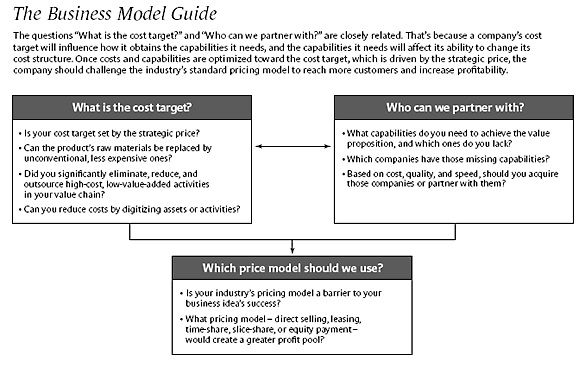
The Business Model Guide helps you answer the following questions:
- What is the cost target?: New Businesses have a hard time keeping down the costs of new products. Naturally their price points are also higher than they should strategically be. Therefore, you should have market-driven strategic price and cost approach. You must refuse to allow for overruns and force your organisations to question virtually every assumption about materials, design, and manufacturing—often with surprising results.
- Who can we partner with? : Look for partners to ensure spped to market. Building capabilities ight slow you down and other players may enter the market.
- Which price model should we use? : To be sucessful, please do not assume that there’s only one way to price a product.
Steps to starting a business in India
Starting a business requires continuous and sustainable disciplined efforts.
Take up one idea. Make that one idea your life. Think of it, dream of it, live on that idea. Let the brain, muscles, nerves, every part of your body, be full of that idea, and just leave every other idea alone. This is the way to success. That is way great spiritual giants are produced.”
Several of my clients believe that the best way to develop a business idea is to throw 100 brilliant strategies in the market. However, a successful business idea takes much more than that.
Have you seen the movie “Eddie the Eagle“? In this film, professional ski jumpers talk about success coming through a disciplined training process. Similar is the case with a business idea.
I recommend you see Eddie the Eagle.
When you coin it, it is easy to consider that you will just go out there and you will be able to jump like a professional who started training at the age of 6. However, if you persevere like Eddie and are not afraid of falling like him, surely you will begin to succeed.
Therefore, I really believe in PDCA cycle, also known as Deming Cycle. PDCA is a four-step management method used in business for the control and continual improvement of processes and products.
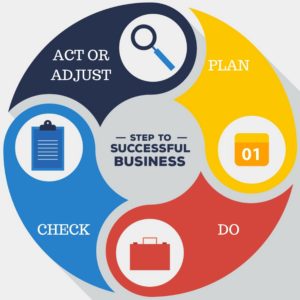
PDCA Cycle
- Plan: During the planning stage you need to establish the business objectives. It is preferable to run an experiment on a small scale to develop the cause and effect relationship. During this stage, you also identify several strategies and processes to generate essential results.
- Do: During this stage, you actually execute the plan as per the defined mechanism in step one. At the same time, you also collect the data for analysis in the next stage. During this phase, you actually take your idea to the world and test it out among real customers.
- Check: In this phase, you actually process the data collected in the previous step and study the results against business objectives. It is essential to determine if there are any deviations.
- Act or Adjust: This is the last phase where you take an informed decision to continue or abandon the Business idea you have.
- If you decide to go ahead, it is essential to identify what you need to improve upon in the next phases.
- If you drop the business idea, it is a must that you learn something out of it and redraw your business idea.
Summary: Building a Business Idea
To successfully develop a business idea, it is a must that you follow a disciplined process.
To turn really interesting ideas and fledgling technologies into a company that can continue to innovate for years, it requires a lot of disciplines
– Steve Jobs
How to protect your business idea
You can consider a patent for your business idea or product if you think it is revolutionary. A patent will help you retain the rights to it and earn higher margins if your product is patented.
Please note that a patent-able business idea need not be a breakthrough scientific innovation to be eligible for a patent. It can be patented even if it is just a process invention.
A patent provides you exclusive rights thereby giving you higher ROIs, better brand images as the inventor and help you build your credibility in the marketplace.
How to name your business idea
Brand names are the lifeline of any business idea. If the brand name does not resonate with its customers, the chances are that the company is doomed. Below are tips on how to Choose ROI Driving Business Name
- Choose a Business Name that is Short, web-friendly and available to register
- Always choose a short Brand name for your business idea.
- Try to get .com domain as most of the customers are tuned to type the brand name followed by .com otherwise go with the most preferred country suffix such as .in or .cn or .uk or .de.
- Ensure it is not similar to an incumbent in your product/service category
- Choose a Brand name that is easy to remember
- Make sure that Social media user /account names are available
- Make sure the colloquial meaning of brand name is not hurting public sentiments
- Choose a Business Name that is Easy to Pronounce and Spell. For example, the spelling of Xerox should be Zerox as per its pronunciation.
- Choose a Business name that is easy to remember
- If possible consider a brand name that creates curiosity and inspires a consumer to inquire further.
- Choose a Business name which can be easily converted into a meaningful Logo
I hope that the above tips will help you choose an exciting brand name for your business idea. Let me know if you want me to add anything additional here.
How to Promote a Business Idea
All of us have been witnessing several start-ups like Flipkart, Uber, Xiaomi becoming successful today. However, at times we forget to notice there were thousand more equally promising start-ups that never saw any success.
All these start-ups have leveraged internet to build their business idea.
So, what separates the one that are successful and the others that are not.
What a start-up must do to succeed
Yes, online innovations are increasingly becoming bigger & better and loved by today’s young consumer.
At times several such innovations take indefinite amount of time to catch consumer fancy. As some of these innovations are ahead of their time.
However, what a start-up or marketer do to achieve traction of an online business idea?
The answer to this question is in decades old tried and tested practice called “Diffusion of Innovation”.
Steve Jobs said “To turn really interesting ideas and fledgling technologies into a company that can continue to innovate for years, it requires a lot of disciplines.”
Diffusion of Innovation is that scientific process that helps you hustle your business ideas to success. If you deploy this you can certainly achieve the fancy of your prospective consumers.
Why Innovation is critical for the world
However, before I share more info, please understand that your business idea is much bigger than your desire to be on your own.
- Introduction of new products and services is vital to the consumer, marketer and the world economy.
- For the consumer, new products and services represent increased opportunities to satisfy personal, social and environmental needs.
- At the same point for a marketer, it provides and important mechanism to keep the firm competitive and profitable.
- For the world, it represents potential improvement in the quality of life for people.
Therefore, your business idea has to have a purpose, purpose to make the world a better place.
What is Diffusion of Innovation
Over decades marketers have trusted a framework to accelerate the consumer acceptance of innovative products and services. This framework is called DIFFUSION OF INNOVATION.
This framework enables you take advantage of five product / service characteristics that seems to influence consumer acceptance of innovative products/services.
- Relative Advantage: The degree to which potential customer perceive a new product as superior to existing product.
- Compatibility: The degree to which potential consumers feel a new product is consistent with their needs, values and practices.
- Complexity: The degree to which an innovative product is difficult to understand or use,
- Trialability: The degree to which a new product is capable of being tried on a limited basis.
- Observability: Is the ease with an innovative product benefits or attributes can be absorbed, imagined or described to potential consumers.
For ages marketers have been using this framework to promote innovative products and services. However, with the evolution of internet this framework has evolved a lot.
Diffusion of Online Innovation
The five product characteristics that seem to influence consumer acceptance of an innovation online have evolved to:
-
Visibility (evolved from Relative advantage):
- Visibility is critical as we build our online marketing plans. We can offer the best products and services, but if nobody knows about the product and why it is better, what’s the point? Visibility comes from a number of marketing channels, including advertising, organic search, social media marketing, online PR, or e-mail. These visibility options may require space on your Web pages, may be integrated into design, require additional budgeting, or take some technological setup.
-
Credibility (evolved form of compatibility):
- Credibility is exuded in websites, blogs, images, videos, PR, social media, or reviews. You never have a second chance to make a great first impression. Building credibility & trust is an online marketing must and first practice.
-
Usability (evolved form of Complexity):
- Usability comes from appropriate and professional design, site architecture, clear navigation, call to actions, e-mails, content, and even social media.
-
Sell-ability (evolved from Trialability):
- Sell-ability is a critical online marketing planning piece, as this is how well you show, and tell, and sell the value of your organization, products, and services. People need to understand why you or your organization are worth working with. This can come through videos, testimonials, press releases, taglines, and images.
-
Scalability (evolved from Observability):
- When we employ credibility, usability, visibility, and sell-ability, we reap the benefits of scalability. Online marketing efforts lasts a lifetime on the Web, building and compounding overtime. Scalable ideas are like ELSS (equity linked saving schemes). Small investments made consistently over time can grow to support your organization’s overall Web presence and marketing.

